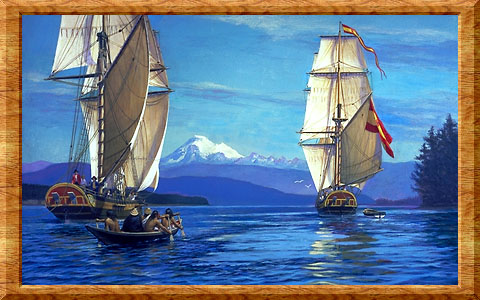
Original acrylic 18" x 28" by Bill Holm © 1995
Collection of Dr. James Richardson
Near midday of June 11, 1792, two small Spanish ships, Sutil and Mexicana, under the commands of the young Frigate Captains Don Dionisio Alcalá-Galiano and Don Cayetano Valdés y Flores, sailed into Guemes Channel near the present city of Anacortes, Washington. Their mission was to explore and chart the waterways inside Juan de Fuca Strait and, if there would be such a channel, locate the fabled "Northwest Passage" to the Atlantic. The two little ships (about 45 feet on the waterline) had sailed here from Acapulco in southern Mexico, via Nootka Sound, where they had been refitted and provisioned. The evening before they had anchored off the southeast point of Lopez Island, and a party had gone ashore to observe the emergence of the first moon of Jupiter in order to correct their longitude. This observation was probably made on the artist's property at Watmough Head, Lopez Island!
The light, following breeze was not strong enough to allow the two ships to buck the tidal current in the centre of Guemes Channel, so they stayed close to the south shore to take advantage of the side eddies along Fidalgo Island. Four young Indians and an older man from the village on Guemes Island paddled expertly out to the ships and traded blackberries, dried clams, and a dog-wool robe lined with feathers, for buttons and beads. The young artist on Mexicana, José Cardero, captured the incident in a spectacular painting now in the Museo Naval in Madrid. His view of the two ships in Guemes Channel, with Mount Baker looming on the horizon, was the inspiration for this painting of a setting very familiar to me.
I am much indebted to Mark Myers, RSMA, F/ASMA, for detailed information on the two ships, and especially for his interpretation of José Cardero's drawings of the unusual riggings of Mexicana's main mast.